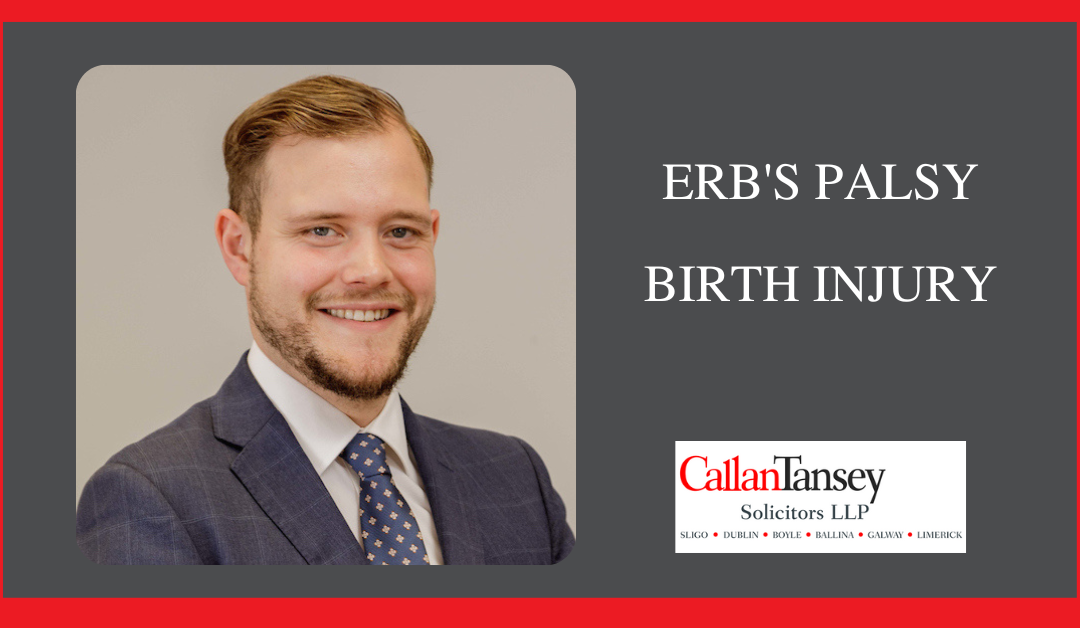The Medical Negligence team at Callan Tansey Solicitors LLP has successfully represented many people with Erb’s Palsy. Our work has got explanations from the hospitals concerned as to how this injury occurred. We have also secured compensation for this birth injury for our clients. In fact, Johan Verbruggen, Associate Solicitor in our Galway office has Erb’s Palsy. His parents successfully brought a case on his behalf many years ago. His lived experience helps support clients and families who have been affected by Erb’s Palsy.
What is Erb’s Palsy?
Obstetric brachial plexus palsy, or as it is colloquially termed, Erb’s Palsy, is a nerve injury, causing a part or complete paralysis in the affected arm.
What is the brachial plexus?
The brachial plexus is the name given the group of five nerves at the root of the neck (C5, C6, C7, C8 and T1) that travel from the neck to the shoulder. These nerves control the sensation and movement in the arm and hand.
What causes Erb’s Palsy?
In some births, and in particular those involving large babies, the baby’s shoulder may become stuck behind the mother’s pubic bone after the head is delivered. This complication is called shoulder dystocia.
When shoulder dystocia occurs, it is inappropriate to pull excessively or downward on the baby’s head to deliver it. Such pulling causes the head to come away from the stuck shoulder. This stretches and tears the nerves in the brachial plexus and in severe cases, tearing them from the spinal cord. Unfortunately, we see from an investigation of the records, cases where this birth complication is not dealt with appropriately.
The nature and extent of paralysis depends on the amount of stretch force. As the baby’s shoulder and head move apart. Paralysis falls under four primary classifications: avulsion, rupture, neuroma and neuropraxia.
What are the symptoms of Erb’s Palsy?
Depending on the severity of the nerve damage, symptoms can include:
- Lack of power in fingers and thumbs,
- Reduced bone growth in the affected hand and arm
- Reduced flexibility in the affected arm
- Reduced sensation in the affected arm and hand
How common is Erb’s Palsy?
One or two out of every 1000 babies present with Erb’s Palsy. With greater awareness, knowledge and training in the medical community on how to appropriately deliver babies that encounter shoulder dystocia, it has been seen that while the incidence of shoulder dystocia is increasing year on year, the incidence of Erb’s Palsy is falling.
How is Erb’s Palsy treated?
The treatment depends on the severity of the injury. Usually exercises and physical therapy is recommended once a baby reaches the age of three weeks. Erb’s Palsy is best rehabilitated through timely interventions such as:
- Physiotherapy
- Occupational Therapy
- Surgery (such as nerve graft, muscle transfer or tendon transfer)
What are the outcomes if treatment does not work?
While some cases of Erb’s Palsy respond well to early intervention and treatment this is not always the case. If someone with Erb’s Palsy does not recover function early, they are likely to have a permanent lifelong disability in the arm.
Is it possible to seek compensation for an Erb’s Palsy birth injury?
Yes. There are established manoeuvres that can help release the obstructed shoulder without resorting to inappropriately pulling on the baby’s head. If an obstetrician or midwife has not appropriately managed the shoulder obstruction, and has resorted to excessive or downward pulling on the baby’s head, then that could be a breach of duty of care.
If there is an indication during the pregnancy that the baby will likely be large, then the risks of delivering a large baby, such as shoulder dystocia should be discussed with an expectant mother. This is so that an informed decision can be made as to the mode of delivery: vaginal birth or caesarean section. Risk factors would include:
- Shoulder dystocia in a previous birth
- A maternal family history of large babies
- The mother has diabetes
- The second stage of labour is prolonged
If you believe that your child developed Erb’s palsy as a result of a breach of duty of care, your child may be entitled to compensation. While parents may hope the issue resolves over time or with treatment it is advisable to speak with an experienced Medical Negligence solicitor as early as possible. Medical Negligence cases can take a number of years to reach a conclusion. It is important to gather all relevant information at the outset. A Medical Negligence Solicitor can request access to medical records and engage independent medical experts to establish if there was any negligence on the part of the medical team.
How do I make a Medical Negligence Claim for an Erb’s Palsy birth injury?
Once an independent medical expert has advised your solicitor that they believe negligence did occur you can instruct your solicitor to begin the process of issuing legal proceedings against the medical team and the hospital. It is important to note that the legal time limit to make a medical negligence claim is two years from the date of injury, or knowledge of the injury. In the case of children, the time limit expires two years after they reach the age of eighteen.
If you have any questions about issues raised in this article you can contact Johan Verbruggen of our Medical Negligence team on 091 865 000.
*In contentious business, a solicitor may not calculate fees or charges as a percentage or proportion of any award or settlement.


